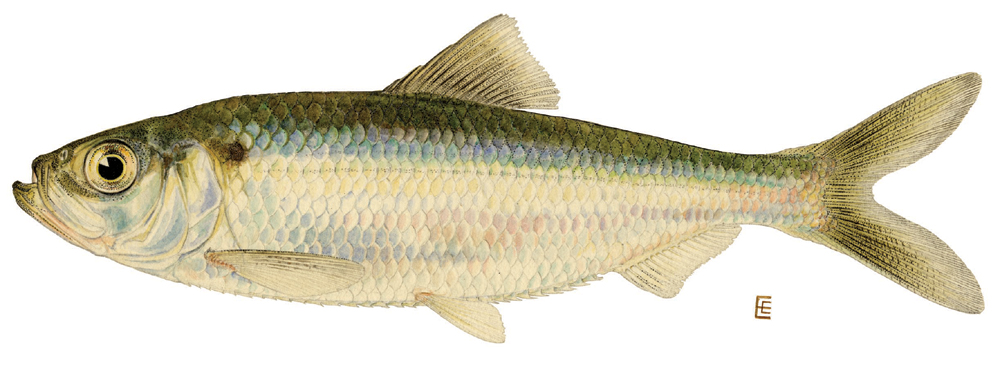The Environmental and Ecological Importance of Thiamine and Thiamine Deficiency in Aquatic Food Webs
Collaborators: Dale Honeyfield, USGS Northern Appalachian Research Lab; Esther Angert, Dept. of Microbiology, Cornell)
 For the past 30 years Great Lakes
scientists have been trying to put together an extraordinary puzzle resulting in the reproductive failure of lake trout and Atlantic salmon, two valuable native Great Lakes fishery resources. "Early mortality syndrome" (EMS) is another name for a thiamin deficiency that results in the complete reproductive failure of certain predatory fish - such as lake trout and Atlantic salmon - that feed on forage fish containing thiaminase, a thiamin destroying enzyme. Members of the herring family such as alewife are particularly prone to having high thiaminase levels, and alewife are the most abundant Great Lakes forage fish fed upon by large predators. Unfortunately, EMS is not limited to the Great Lakes and has also been observed to limit reproduction by Baltic Sea Atlantic salmon that feed upon Baltic herring. Although EMS has been observed for over 30 years, the cause of this problem has resisted understanding as scientists have explored a series of explanations regarding factors that influence thiamin and thiaminase in fish.
For the past 30 years Great Lakes
scientists have been trying to put together an extraordinary puzzle resulting in the reproductive failure of lake trout and Atlantic salmon, two valuable native Great Lakes fishery resources. "Early mortality syndrome" (EMS) is another name for a thiamin deficiency that results in the complete reproductive failure of certain predatory fish - such as lake trout and Atlantic salmon - that feed on forage fish containing thiaminase, a thiamin destroying enzyme. Members of the herring family such as alewife are particularly prone to having high thiaminase levels, and alewife are the most abundant Great Lakes forage fish fed upon by large predators. Unfortunately, EMS is not limited to the Great Lakes and has also been observed to limit reproduction by Baltic Sea Atlantic salmon that feed upon Baltic herring. Although EMS has been observed for over 30 years, the cause of this problem has resisted understanding as scientists have explored a series of explanations regarding factors that influence thiamin and thiaminase in fish.
We conducted a series of pond and laboratory experiments to evaluate the influence of stressful environmental conditions (e.g. low food consumption, temperature and physiological stress) upon thiaminase levels in alewife and gizzard shad. In our experiments, thiaminase levels in these Clupeid fishes always increased in response to increasing fish condition (assessed by measuring the proportion of body weight comprised of dry matter), suggesting that high food consumption was the key factor responsible for high thiaminase levels. One potential explanation for the observation that high levels of food consumption result in high thiaminase levels is that bacteria in alewife and gizzard shad gastrointestinal tracts produce thiaminase, and these bacteria thrive when provided with steady food inputs and environmental conditions associated with high levels of food consumption.
The ultimate goal of this work is to develop management actions that will reduce thiaminase levels in Great Lakes fishes, leading to the re-establishment of self-sustaining populations of lake trout and Atlantic salmon.
For further information:
Lepak, J.M., C.E. Kraft, D.C. Honeyfield and S.B. Brown. 2008. Evaluating the effect of stressors and immunosuppression on thiaminase in alewife. Journal of Aquatic Animal Health 20:63-71. [Link to Full article]
Lepak, J.M., C.E. Kraft, and M.J. Vanni. 2013. Clupeid response to stressors: the influence of environmental factors on thiaminase expression. Journal of Aquatic Animal Health 25:90-97. [Link to Full article]